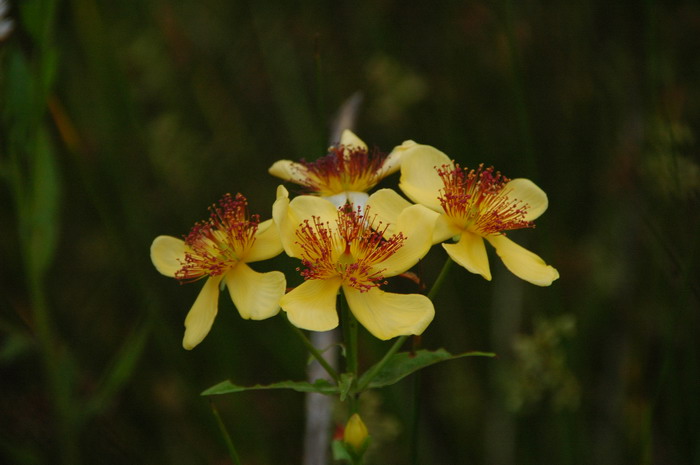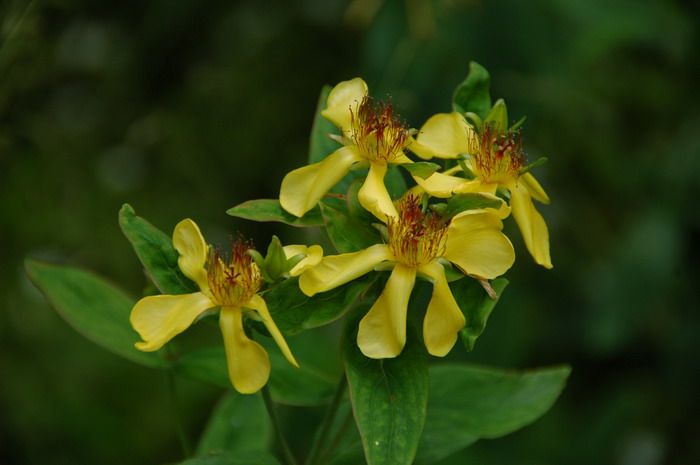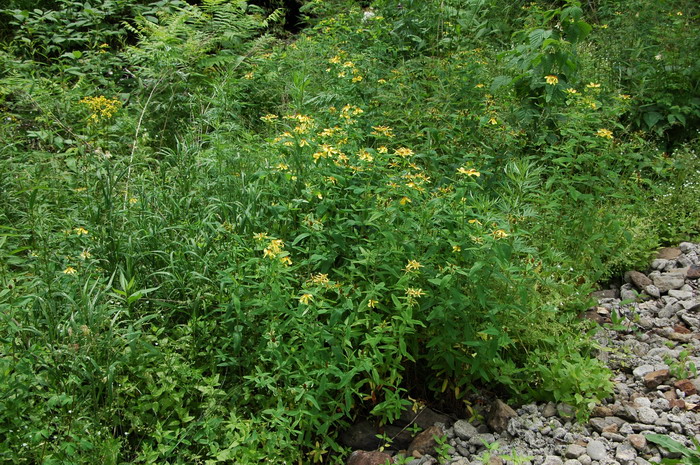长柱金丝桃Hypericum ascyron
中文名(Chinese Name):长柱金丝桃
学名(Scientific Name):Hypericum ascyron L.
英文名(English Common Name):great St. Johnswort
别名(Chinese Common Name):黄海棠、山辣椒、大叶金丝桃
异名(Synonym):Ascyrum sibiricum Lam. ex Poir. Hypericum scallanii R. Keller Hypericum ascyron var. giraldii R. Keller Hypericum ascyron var. hupehense Pamp. Hypericum ascyron var. longistylum Maxim. Hypericum ascyron var. micropetalum R. Keller Hypericum longifolium H. Lév. Hypericum ascyron var. genuinum Maxim. Hypericum ascyron var. umbellatum R. Keller Hypericum hemsleyanum H. Lév. et Vaniot Hypericum biondii R. Keller Roscyna gmelinii Spach Roscyna japonica Blume Hypericum pyramidatum Ait. Ascyrum tetragonum Moench Hypericum salicaria Rchb.
科属(Family & Genus):藤黄科(Guttiferae)金丝桃属
形态特征(Description):多年生草本,高0.5-1.3米。茎直立或在基部上升,单一或数茎丛生,不分枝或上部具分枝,有时于叶腋抽出小枝条,茎及枝条幼时具4棱,后明显具4纵线棱。叶无柄,叶片披针形、长圆状披针形、或长圆状卵形至椭圆形、或狭长圆形,长(2-)4-10厘米,宽(0.4-)1-2.7(3.5)厘米,先端渐尖、锐尖或钝形,基部楔形或心形而抱茎,全缘,坚纸质,上面绿色,下面通常淡绿色且散布淡色腺点,中脉、侧脉及近边缘脉下面明显,脉网较密。花序具1-35花,顶生,近伞房状至狭圆锥状,后者包括多数分枝。花直径(2.5-)3-8厘米,平展或外反;花蕾卵珠形,先端圆形或钝形;花梗长0.5-3厘米。萼片卵形或披针形至椭圆形或长圆形,长(3-) 5-15 (-25)毫米,宽1.5-7毫米,先端锐尖至钝形,全缘,结果时直立。花瓣金黄色,倒披针形,长1.5-4 厘米,宽0.5-2厘米,十分弯曲,具腺斑或无腺斑,宿存。雄蕊极多数,5束,每束有雄蕊约30枚,花药金黄色,具松脂状腺点。子房宽卵珠形至狭卵珠状三角形,长4-7(-9)毫米,5室,具中央空腔;花柱5,长为子房的1/2至为其2倍,自基部或至上部4/5处分离。蒴果为或宽或狭的卵珠形或卵珠状三角形,长0.9-2.2厘米,宽0.5-1.2厘米,棕褐色,成熟后先端5裂,柱头常折落。种子棕色或黄褐色,圆柱形,微弯,长1-1.5毫米,有明显的龙骨状突起或狭翅和细的蜂窝纹。花期7-8月,果期8-9月。
分布(Distribution):除新疆及青海外,全国各地均产。生于海拔2800米以下山坡林下、林缘、灌丛间、草丛或草甸中、溪旁及河岸湿地等处。俄罗斯、朝鲜、日本、越南、美国、加拿大也有。
用途(Use):全草药用,主治吐血、子宫出血、外伤出血、疮疖痈肿、风湿、痢疾以及月经不调等症;种子泡酒服,可治胃病,并可解毒和排脓。全草也是烤胶原料。此外民间有用叶作茶叶代用品饮用。也可供观赏。
引自中国植物志英文版 FOC Vol. 13 Page 4, 20, 21
Hypericum ascyron Linnaeus, Sp. Pl. 2: 783. 1753.
黄海棠 huang hai tang| Clusiaceae | Hypericum
Herbs, perennial, 0.5-1.3(-2) m tall, erect or sometimes ascending from short creeping base; stems single or few, cespitose, unbranched or branched above or nearly throughout. Stems 4-angled when young, becoming 4-lined or occasionally internodes 2-lined below. Leaves sessile; blade lanceolate or ± narrowly ovate or oblong or elliptic to oblong-linear or oblanceolate, (3-)4-9.7(-12) × (0.4-)0.7-3.5(-4) cm, thickly papery, abaxially rather paler but not glaucous; laminar glands dense, unequal dots or short streaks; intramarginal glands dense; main lateral veins 4-7-paired, tertiary reticulation dense, often obscure; base cuneate to cordate-amplexicaul, apex acute to subapiculate or obtuse (or lowermost rarely rounded). Inflorescence 1- to ca. 35-flowered from 1-5 nodes, the whole nearly flat-topped to narrowly pyramidal, sometimes with flowering branches from up to 4 nodes below; bracts and bracteoles leaflike but smaller and often broader, more rarely linear-lanceolate and deciduous. Flowers 3-7(-8) cm in diam., stellate with petals spreading to reflexed; buds broadly to narrowly ovoid, apex rounded to subacute. Sepals free, erect, oblong to elliptic or ovate to ovate-lanceolate or obovate, subequal to unequal, the outer ones sometimes leaflike, (0.3-)0.5-1.5 cm × (1.5-)2-7(-10) mm; laminar glands lines, distally interrupted to streaks; marginal glands spaced, small, margin entire, apex rounded to obtuse or rarely subacuminate to acute; veins 11-17. Petals bright (to ?golden) yellow, sometimes tinged red in bud, obovate or oblong-obovate to oblanceolate, often somewhat spatulate to subunguiculate, strongly curved to nearly straight, 1.4-4.1 × 0.5-2 cm, 2-3 × as long as sepals or shorter when sepals leaflike; laminar glands lines to short streaks; marginal glands absent; margin entire, apex rounded or obtuse to rarely acute to acuminate; apiculus short and rounded or absent. Stamen fascicles (?4 or)5, each with ca. 30 stamens, longest 0.9-2.5 cm, 0.4-0.67 × as long as petals. Ovary broadly ovoid to narrowly ovoid-pyramidal or ellipsoid; styles (4 or)5, 2.5-15 mm, 0.5-2 × as long as ovary, free or up to 0.8 coherent or connate; stigmas broadly capitate to funnel-shaped. Capsule broadly to narrowly ovoid or ovoid-pyramidal or rarely narrowly cylindric, 0.9-2.2(-3) cm × 5-13 mm, 2-3 × as long as sepals, apex obtuse to rounded. Seeds dark red-brown to yellow-brown, 1-1.5 mm, deeply carinate or narrowly winged, sometimes with slight terminal expansion; testa densely shallowly linear-reticulate. Fl. Jun-Sep, fr. Aug-Oct. 2n = 16, 18, 20, 22 (usually 18).
Moist to dry meadows, grassy or rocky slopes, sometimes in forests or among scrub, streamsides and river banks; sea level to 2800(-3600) m. Throughout China except Xizang [Japan, Korea, Mongolia, Russia (Altay to Kamchatka and Kurile Islands, Sakhalin), Vietnam; North America (E Canada, NE United States)].
Hypericum ascyron is a highly variable species or species complex with a very wide distribution. Although several variants have been recognized as varieties or even species, the variation appears to be nearly continuous.
The most frequently distinguished taxon has been Hypericum gebleri, which most Russian authors have recognized, as it occurs throughout most of S Siberia along with larger-flowered, less-branched forms and is present alone in Kamchatka, the Kurile Islands, and Sakhalin. On the other hand, Chinese authors have tended to include it in H. ascyron, because intermediate forms occur in the north. The North American population, too, was recognized early at species level but none of the characters said to distinguish it appears to be constant.
Under these circumstances, it seems best to distinguish the N Asian Hypericum gebleri and the North American H. pyramidatum Aiton as subspecies (see Robson, Bull. Nat. Hist. Mus. Lond. (Bot.) 31: 37-88. 2001). It seems impossible to recognize the long-styled (mainly large-flowered and northern) plants and the narrow-fruited, C Chinese ones (respectively var. longistylum and var. giraldii [var. hupehense]) as distinct taxa, as both represent extremes of continuous variation. Likewise, the narrow-leaved, small-flowered form from S China (misidentified as var. angustifolium Y. Kimura) merges with more typical forms.


 (责任编辑:徐晔春)
(责任编辑:徐晔春)
学名(Scientific Name):Hypericum ascyron L.
英文名(English Common Name):great St. Johnswort
别名(Chinese Common Name):黄海棠、山辣椒、大叶金丝桃
异名(Synonym):Ascyrum sibiricum Lam. ex Poir. Hypericum scallanii R. Keller Hypericum ascyron var. giraldii R. Keller Hypericum ascyron var. hupehense Pamp. Hypericum ascyron var. longistylum Maxim. Hypericum ascyron var. micropetalum R. Keller Hypericum longifolium H. Lév. Hypericum ascyron var. genuinum Maxim. Hypericum ascyron var. umbellatum R. Keller Hypericum hemsleyanum H. Lév. et Vaniot Hypericum biondii R. Keller Roscyna gmelinii Spach Roscyna japonica Blume Hypericum pyramidatum Ait. Ascyrum tetragonum Moench Hypericum salicaria Rchb.
科属(Family & Genus):藤黄科(Guttiferae)金丝桃属
形态特征(Description):多年生草本,高0.5-1.3米。茎直立或在基部上升,单一或数茎丛生,不分枝或上部具分枝,有时于叶腋抽出小枝条,茎及枝条幼时具4棱,后明显具4纵线棱。叶无柄,叶片披针形、长圆状披针形、或长圆状卵形至椭圆形、或狭长圆形,长(2-)4-10厘米,宽(0.4-)1-2.7(3.5)厘米,先端渐尖、锐尖或钝形,基部楔形或心形而抱茎,全缘,坚纸质,上面绿色,下面通常淡绿色且散布淡色腺点,中脉、侧脉及近边缘脉下面明显,脉网较密。花序具1-35花,顶生,近伞房状至狭圆锥状,后者包括多数分枝。花直径(2.5-)3-8厘米,平展或外反;花蕾卵珠形,先端圆形或钝形;花梗长0.5-3厘米。萼片卵形或披针形至椭圆形或长圆形,长(3-) 5-15 (-25)毫米,宽1.5-7毫米,先端锐尖至钝形,全缘,结果时直立。花瓣金黄色,倒披针形,长1.5-4 厘米,宽0.5-2厘米,十分弯曲,具腺斑或无腺斑,宿存。雄蕊极多数,5束,每束有雄蕊约30枚,花药金黄色,具松脂状腺点。子房宽卵珠形至狭卵珠状三角形,长4-7(-9)毫米,5室,具中央空腔;花柱5,长为子房的1/2至为其2倍,自基部或至上部4/5处分离。蒴果为或宽或狭的卵珠形或卵珠状三角形,长0.9-2.2厘米,宽0.5-1.2厘米,棕褐色,成熟后先端5裂,柱头常折落。种子棕色或黄褐色,圆柱形,微弯,长1-1.5毫米,有明显的龙骨状突起或狭翅和细的蜂窝纹。花期7-8月,果期8-9月。
分布(Distribution):除新疆及青海外,全国各地均产。生于海拔2800米以下山坡林下、林缘、灌丛间、草丛或草甸中、溪旁及河岸湿地等处。俄罗斯、朝鲜、日本、越南、美国、加拿大也有。
用途(Use):全草药用,主治吐血、子宫出血、外伤出血、疮疖痈肿、风湿、痢疾以及月经不调等症;种子泡酒服,可治胃病,并可解毒和排脓。全草也是烤胶原料。此外民间有用叶作茶叶代用品饮用。也可供观赏。
引自中国植物志英文版 FOC Vol. 13 Page 4, 20, 21
Hypericum ascyron Linnaeus, Sp. Pl. 2: 783. 1753.
黄海棠 huang hai tang| Clusiaceae | Hypericum
Herbs, perennial, 0.5-1.3(-2) m tall, erect or sometimes ascending from short creeping base; stems single or few, cespitose, unbranched or branched above or nearly throughout. Stems 4-angled when young, becoming 4-lined or occasionally internodes 2-lined below. Leaves sessile; blade lanceolate or ± narrowly ovate or oblong or elliptic to oblong-linear or oblanceolate, (3-)4-9.7(-12) × (0.4-)0.7-3.5(-4) cm, thickly papery, abaxially rather paler but not glaucous; laminar glands dense, unequal dots or short streaks; intramarginal glands dense; main lateral veins 4-7-paired, tertiary reticulation dense, often obscure; base cuneate to cordate-amplexicaul, apex acute to subapiculate or obtuse (or lowermost rarely rounded). Inflorescence 1- to ca. 35-flowered from 1-5 nodes, the whole nearly flat-topped to narrowly pyramidal, sometimes with flowering branches from up to 4 nodes below; bracts and bracteoles leaflike but smaller and often broader, more rarely linear-lanceolate and deciduous. Flowers 3-7(-8) cm in diam., stellate with petals spreading to reflexed; buds broadly to narrowly ovoid, apex rounded to subacute. Sepals free, erect, oblong to elliptic or ovate to ovate-lanceolate or obovate, subequal to unequal, the outer ones sometimes leaflike, (0.3-)0.5-1.5 cm × (1.5-)2-7(-10) mm; laminar glands lines, distally interrupted to streaks; marginal glands spaced, small, margin entire, apex rounded to obtuse or rarely subacuminate to acute; veins 11-17. Petals bright (to ?golden) yellow, sometimes tinged red in bud, obovate or oblong-obovate to oblanceolate, often somewhat spatulate to subunguiculate, strongly curved to nearly straight, 1.4-4.1 × 0.5-2 cm, 2-3 × as long as sepals or shorter when sepals leaflike; laminar glands lines to short streaks; marginal glands absent; margin entire, apex rounded or obtuse to rarely acute to acuminate; apiculus short and rounded or absent. Stamen fascicles (?4 or)5, each with ca. 30 stamens, longest 0.9-2.5 cm, 0.4-0.67 × as long as petals. Ovary broadly ovoid to narrowly ovoid-pyramidal or ellipsoid; styles (4 or)5, 2.5-15 mm, 0.5-2 × as long as ovary, free or up to 0.8 coherent or connate; stigmas broadly capitate to funnel-shaped. Capsule broadly to narrowly ovoid or ovoid-pyramidal or rarely narrowly cylindric, 0.9-2.2(-3) cm × 5-13 mm, 2-3 × as long as sepals, apex obtuse to rounded. Seeds dark red-brown to yellow-brown, 1-1.5 mm, deeply carinate or narrowly winged, sometimes with slight terminal expansion; testa densely shallowly linear-reticulate. Fl. Jun-Sep, fr. Aug-Oct. 2n = 16, 18, 20, 22 (usually 18).
Moist to dry meadows, grassy or rocky slopes, sometimes in forests or among scrub, streamsides and river banks; sea level to 2800(-3600) m. Throughout China except Xizang [Japan, Korea, Mongolia, Russia (Altay to Kamchatka and Kurile Islands, Sakhalin), Vietnam; North America (E Canada, NE United States)].
Hypericum ascyron is a highly variable species or species complex with a very wide distribution. Although several variants have been recognized as varieties or even species, the variation appears to be nearly continuous.
The most frequently distinguished taxon has been Hypericum gebleri, which most Russian authors have recognized, as it occurs throughout most of S Siberia along with larger-flowered, less-branched forms and is present alone in Kamchatka, the Kurile Islands, and Sakhalin. On the other hand, Chinese authors have tended to include it in H. ascyron, because intermediate forms occur in the north. The North American population, too, was recognized early at species level but none of the characters said to distinguish it appears to be constant.
Under these circumstances, it seems best to distinguish the N Asian Hypericum gebleri and the North American H. pyramidatum Aiton as subspecies (see Robson, Bull. Nat. Hist. Mus. Lond. (Bot.) 31: 37-88. 2001). It seems impossible to recognize the long-styled (mainly large-flowered and northern) plants and the narrow-fruited, C Chinese ones (respectively var. longistylum and var. giraldii [var. hupehense]) as distinct taxa, as both represent extremes of continuous variation. Likewise, the narrow-leaved, small-flowered form from S China (misidentified as var. angustifolium Y. Kimura) merges with more typical forms.
踩一下[0]

顶一下[0]